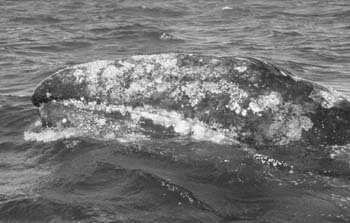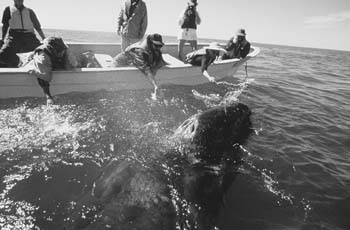Battle of the Giants
A Whale's Tale: In their Baja California breeding grounds, whales complete a mating cycle that takes them thousands of miles along the Pacific Coast in a yearly migration.
The California gray is the poster whale for endangered-species protection, but the sea mammoth's comeback may be imperiled by an environmental crisis in its breeding lagoons
By Eric Johnson
'THERE'S ITS BELLY. That one looks like it's rolling over on its back or something--OK, now there's its side ridge, you can see that very clearly." Nancy Black, the marine biologist aboard the Point Sur Clipper, is describing a scene taking place fewer than 30 yards off the boat's starboard bow. Two California gray whales, each better than 40 feet long, have been wandering around for more than half an hour--"meandering," the professionals call it--and we've been meandering around with them.
"We're getting a really good look now at what is probably some mating behavior," Black tells us--a motley crew of 25 whale-watchers gripping the rail in rapt silence.
Every five minutes or so, the whales surface together, blow sea water 10 feet into the air in a wide "V" and loll around each other in a huge slow-motion dance. This time, it looks like they might get serious, but then they undulate into a slow dive, flip the six-foot span of their tails in the air and disappear.
"OK, they've shown their tail flukes, so they'll be down for five or six minutes," Black says--a refrain she has repeated after each dive, on a mission to impart a rudimentary education in whale biology. "That flat area in the water is called a fluke print," she explains, prompting a Japanese woman to point it out for her 7-year-old daughter.
Following half of these dives, Richard Ternullo, the Point Sur Clipper's captain, seems to know exactly where the whales will come up. When I ask him how he does it--the Echosounder depth finder, the Loran radar or some sixth sense--he points to his $10 fisherman's sunglasses. "They're polarized," he grins. "I can see 'em."
There is, regardless of the captain's modesty, probably some ESP at work. Ternullo has been leading whale-watching tours in Monterey Bay for 25 years. Not much past 40, he is nevertheless the unofficial dean of cetacean tourism in the region.
Earlier, on our way out to this place he calls the "whale track," which is five miles past Point Piños--the southernmost tip of the bay--Ternullo told me that he has seen big changes in these waters since he first took the helm of one of his family's fishing boats.
"We'd see a few grays, back when I was about 15--there were maybe 10,000 altogether," he said. "Now there are 25,000. It's one of the world's greatest endangered-species success stories."
Ternullo, who generally answers questions with a reticence that seems to fit a fisherman trained in the sciences, isn't exaggerating. The Eastern Pacific gray--also known as the California gray--is the only whale species to have experienced such a complete recovery since commercial whaling was banned in 1986.
Boycotts and Banking : The gray whale's last wild refuge is threatened by Mitsubishi/Mexicomine
The dramatic comeback is due, in part, to a behavioral characteristic specific to gray whales. Each year, all of them make a 5,000-mile pilgrimage from their feeding waters in Alaska to one of four lagoons in Mexico's Baja California peninsula. The whales, which practice what biologists term "promiscuous" mating habits, know they can find romance in these tropical waters. It's an efficient reproductive program.
But now, one of the biggest of those breeding and birthing grounds, Laguna San Ignacio, lies in the heart of a heated controversy. The salt company Exportada de Sal (ESSA), co-owned by the Mexican government and the Tokyo-based Mitsubishi Corporation, plans to build the world's biggest salt-evaporation mine right on the banks of the lagoon.
Black and Ternullo, along with scientists and environmentalists from around the world, fear that gray whales may be facing a serious threat--fewer than four years after being removed from the endangered species list.
"The lagoons are important, because the whales know that there are specific places where they can find a mate," Ternullo explains. "I don't know what the Mexican government is thinking. I just can't figure it out."
Touched by Tourists: Gray whales in the San Ignacio Lagoon often come right up to the sides of whale-watching boats.
Gray Lagoon
LAGUNA SAN IGNACIO is located on Baja's west coast, 600 miles south of San Diego. Getting there requires navigating two hours of treacherous road through an area that ESSA describes as barren and worthless. On the company's Web site, a page labeled "Physical Characteristics" describes the place only as containing "thousands of acres of level, virtually lifeless areas."
Ten years ago, however, six million acres surrounding the lagoon were designated the Vizcaino Biosphere Reserve--in recognition of its pristine environment and importance to wildlife--making it the largest nature preserve in Latin America.
Peregrine falcons thrive there, as do endangered pronghorn antelope and black sea turtles. It is home to one of the West Coast's largest brown pelican rookeries. But the Vizcaino derives its importance as a biological resource--and as an eco-tourism destination--from the gray whales.
The second-largest of the Pacific grays' four "nurseries," San Ignacio is the only one that is still completely undisturbed. Because of its isolated location and untouched environment, the place affords a unique opportunity to experience gray whales in their wild habitat: the whales in the three other lagoons shun people.
Anyone who has seen film footage of friendly grays approaching boats has witnessed the scene at San Ignacio. Even from aboard the Big Sur Clipper, whale watchers remain at a slight distance from the grays. Unlike humpbacks, which are often extremely gregarious, grays rarely approach boats in the open sea. But at San Ignacio, they seem to enjoy human company.
Mother whales routinely piggyback their calves up to skiffs so eco-tourists can rub their bellies. It appears, according to numerous accounts from the area, that they are exhibiting a kind of interspecies motherly pride.
Nathan LaBudde, an organizer with the Earth Island Institute who has been to the lagoon three times and is heading there this week, says the wild aspect of the place is too valuable to allow the massive development to go forward.
"This place is like Yellowstone," LaBudde says, "and building a massive industrial development there would be like putting a mine in Yellowstone."
Mitsubishi and its Mexican partners propose building a 103-square-mile salt-evaporation project--the largest of its kind in the world. It would require pumping millions of gallons of water from the lagoon out across an area half the size of Santa Cruz County.
The salt left behind after the evaporation process would be scraped up with bulldozers and trucked to a mile-long pier at the mouth of the lagoon. It would then be shipped by barge to Japan and the U.S., where it would be used to produce plastic and road salt, and in other industrial processes.
The project's backers insist that the salt mine will not harm the environment. The ESSA Web site, which features more than 20 photos of gray whales in the lagoon, promises that the mine will have no impact whatsoever on the whales and will create a wetland, thereby increasing bird populations. The developers have even convened an international team of scientists to study the project in order to predict what will happen.
LaBudde says there is little need for scientific crystal-ball gazing. To demonstrate the development's potential impact, he points to another salt mine 50 miles up the coast.
The Guerrero Negro lagoon was once a major birthing and breeding ground for grays. In 1954, ESSA built an evaporation project there. LaBudde says that during the 13 years that the company shipped salt from the area, the gray whales abandoned it as a nursery--a claim that is backed by a member of ESSA's own team in a document on the company's Web site.
LaBudde charges that while the company's public pronouncements put on a show of ecological concern, its official documents prove otherwise. He and other activists point to the 465-page environmental impact assessment ESSA filed with the Mexican government, which devotes only 23 lines to gray whales.
The Green Glow
PERHAPS BECAUSE his love of nature is not restricted to the whale family, and perhaps because his love of science causes him to shun magical thinking, Bernie Tershy feels the need to clear up some things before talking about why whales deserve protection.
"They're just animals," says the UCSC marine biologist and former member of the Sierra Club's board of directors. "They're not magic. They didn't come from outer space."
Tershy says he's seen "too many posters that show a humpback whale or a bottlenose dolphin floating in space, with a pyramid in there somewhere." Although whales and dolphins are his passion and the focus of his career, he wants it made clear that studying mice is as important to him as studying bottlenoses.
"I love whales just like I love all animals," Tershy says. "Not to trivialize or demean whales, but when I try to figure out why people are so fascinated with them, I think the answer is not in whales, it's in people."
Watching the massive mating display from the Point Sur Clipper, some of what Tershy describes was apparent.
After the first couple of hours out, we had learned how to locate the creatures underwater. "Look for the green glow," Nancy Black said, and sure enough, out of the deep, a huge, white-barnacled form could be seen rising, shimmering with wave-patterned greenish sunlight. As its blow spray refracted rainbows in the stiff wind, 25 tourists inhaled simultaneously.
Even the seasoned pros, both scientists, can't disguise their fascination. On a tour two months ago, they witnessed a rare event, something that seems to strain their ability to appear objective.
"We'd been following a single gray, and it was acting kind of funny," Black recounts. "She was arching her back a lot, and then she went down. A few minutes later, a pool of blood floated to the surface, and then a calf came splashing out."
"It thrashed around up there for a couple of minutes," Ternullo says, and Black explains that "they're really clumsy at first."
"But they learn to swim quickly," Ternullo adds.
Not many biologists or professional whale-watchers have witnessed a whale being born, and the experience clearly affected these two seasoned vets. Stories like this clearly contributed to the worldwide movement that led to the international ban on killing whales. Opponents of the San Ignacio salt mine are hoping that a similar passion can be aroused around the gray whale nursery.
To underline the importance of the lagoon's protected waters, Black and Ternullo point out that the calf born in Monterey Bay this winter, whose mother left Alaska late due to El Niño, faced grave risks. But in the final analysis, the issue may not be survival, but the relationship between gray whales and human beings.
On a celebrity-media tour of Laguna San Ignacio last year, Robert Kennedy Jr. made no pretense of selflessness. "We are here for us," he said, actress Glenn Close and her daughter at his side. "The whales enrich us culturally and spiritually. We are not here for the sake of the animals, but for humanity."
[ Santa Cruz | MetroActive Central | Archives ]
Copyright © Metro Publishing Inc. Maintained by Boulevards New Media.
![]()

Richard Sobol--IFAW
![[line]](/gifs/line.gif)
![[line]](/gifs/line.gif)

Richard Sobol--IFAW
From the March 19-25, 1998 issue of Metro Santa Cruz.
![[MetroActive Features]](http://metroactive.com/features/gifs/feat468.gif)